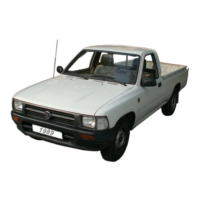
Do you have a question about the Volkswagen Taro 1989 and is the answer not in the manual?
| Engine Type | Diesel |
|---|---|
| Displacement | 2.4 L |
| Cylinders | 4 |
| Valves per Cylinder | 2 |
| Power Output | 54 kW |
Serial number location on cylinder block.
Indicates parts that must be replaced with new ones.
Details on precoated parts and recoating procedures.
Importance of using specified tools and materials for repairs.
Precautions for safe jacking and supporting of the vehicle.
Importance of tagging hoses for correct reconnection.
Guide to identifying bolt strength classes based on markings.
Technical specifications for tune-up, coolant, and oil capacity.
Specification for intake manifold vacuum at idle and 400mm Hg.
Specification for compression pressure at 250 rpm.
Specifications for cylinder head warpage, valve seat, and angle.
Specifications for valve guide bush inside diameter.
Specifications for valve overall length and stem diameter.
Specifications for valve spring free length and installed tension.
Specifications for rocker arm diameter and oil clearance.
Specification for push rod circle runout.
Specifications for chain slack and elongation.
Specifications for tensioner head thickness and damper thickness.
Specifications for valve lifter diameter and oil clearance.
Specifications for camshaft thrust clearance and journal diameter.
Specifications for cylinder head warpage and bore diameter.
Specifications for piston diameter and oil clearance.
Specification for piston ring groove clearance.
Specifications for piston ring end gap.
Specifications for connecting rod thrust clearance and bearing thickness.
Specifications for connecting rod oil clearance.
Specifications for crankshaft thrust clearance and journal diameter.
Causes and remedies for engine overheating.
Causes and remedies for engine starting problems.
Causes and remedies for engine misfires and poor acceleration.
Procedures for checking and replacing engine coolant.
Procedures for checking engine oil quality and level.
Checking the dwell angle and its specification.
Steps for adjusting ignition timing using a timing light.
Additional checks for ignition timing at different RPMs.
How to measure and check CO concentration in exhaust.
Measuring cylinder head warpage using a straight edge.
Inspecting the cylinder head for cracks using a dye penetrant.
Cleaning carbon from valve heads and surfaces.
Measuring valve stem and guide bush dimensions.
Assembling intake and exhaust manifolds.
Installing intake and exhaust manifolds.
Installing the carburetor.
Installing push rods and the rocker shaft assembly.
Installing the cylinder head cover.
Installing spark plug tubes and spark plugs.
Removing the timing chain cover.
Measuring and checking timing chain slack.
Removing the timing chain tensioner.
Removing the timing chain and sprockets.
Installing the timing chain and sprockets with timing marks aligned.
Installing the timing chain tensioner.
Installing the timing chain cover with a new gasket.
Measuring connecting rod thrust clearance.
Removing rod caps and checking oil clearance.
Removing scoring from cylinder bores.
Disconnecting connecting rod from piston using SST.
Measuring piston diameter and oil clearance.
List of oversized piston diameters.
Formula for calculating cylinder boring dimensions.
Checking main journals and crank pins for taper and roundness.
Procedures for removing and installing camshaft bearings.
Fitting bearings into connecting rods and rod caps.
Installing piston and connecting rod assemblies into cylinders.
Fitting connecting rod bearing caps with correct orientation.
Installing the flywheel and torquing.
Installing the clutch disc and cover.
Carburetor specifications for float level, throttle valve angles, etc.
Checking the automatic choke system operation.
Inspecting the choke breaker system operation.
Inspecting the float and needle valve for wear or damage.
Checking the power piston for smooth movement.
Testing the fuel cut-out solenoid valve for proper function.
Removing the float and needle valve.
Removing the needle valve seat and gasket.
Removing the pump plunger and boot.
Removing the coil housing.
Removing the choke breaker component.
Removing the outer vent control valve.
Removing small venturies from the carburetor.
Removing the fuel cut-out solenoid valve.
Removing the auxiliary acceleration pump.
Removing the hot idle compensator.
Removing the secondary throttle valve diaphragm.
Inspecting the float and needle valve for wear or damage.
Checking the power piston for smooth movement.
Testing the fuel cut-out solenoid valve for proper function.
Assembling the carburetor body and flange with new parts.
Fitting the sight glass with new seals.
Assembling the secondary throttle valve diaphragm.
Fitting the secondary throttle valve diaphragm.
Adjusting the primary throttle valve's full opening angle.
Adjusting the secondary throttle valve's full opening angle.
Procedures for disconnecting fuel hoses and removing the fuel pump.
Checking the vacuum switch for continuity.
Inspecting the fuel cut-out solenoid valve.
Diagram showing fuel tank and line components.
Specifications for engine coolant capacity and thermostat valve lift.
Exploded view of water pump components.
Procedures for removing the water inlet and thermostat.
Checking thermostat valve opening temperature and lift.
Procedures for cleaning the radiator core.
Inspecting the radiator cap for proper function.
Specifications for engine oil capacity and oil pressure.
Torque specifications for lubrication system parts.
Troubleshooting common lubrication system problems.
Exploded view of oil pump components.
Procedures for removing the oil pump assembly.
Checking the oil pump's relief valve and rotor clearances.
Specifications for ignition timing, spark plugs, and distributor.
Performing a spark test to check for spark occurrence.
Inspecting the breaker plate for drag.
Inspecting the governor shaft for roughness or wear.
Installing the governor shaft with thrust washer.
Installing the driven gear and plate washer.
Installing the vacuum advancer.
Fitting and adjusting the breaker points.
Overview of emission control systems and their abbreviations.
Procedures for removing, inspecting, and reinstalling the PCV valve.
Visually inspecting PCV hoses and connections.
Checking and adjusting the TP system's operation.
Checking the vacuum gauge and distributor vacuum advancer.
Inspecting AS system hoses, reed valve, and vacuum control valve.
Diagram and purpose of the EVAP system.
Checking the BVSV operation with water and air.
Checking the air control valve operation and hoses.
Checking the bimetal vacuum switching valve and diaphragm.
Checking the BVSV by blowing air into pipes.
Checking the AAP system with cold and warm engines.
Checking the AAP diaphragm operation at idle.
Checking system operation and fuel cut-out solenoid.